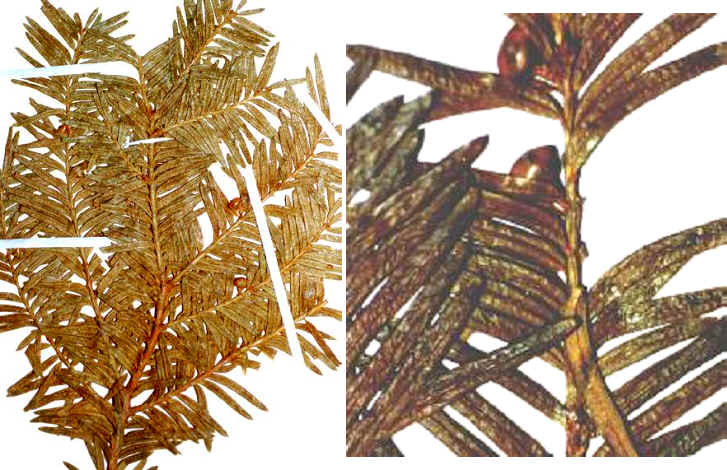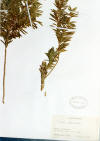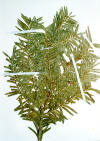|

16j.
Taxus baccata var. subpyramidalis Jacques ex Carrière (Figs.
132–133), Traité Gén. Conif. 519 (1855).
Original material unknown, described as “branches dressées,
nonfastigiées, assez régulièrement rapprochées en pyramide.”
Neotype Proposed: Iran. Guzlu: Mazenderan, in
forest, tree 3 ft diam., Koelz 16208 (US!).
Iran
yew. Known only from Iran.
“Tree,
3 ft diam.” Branches thick, stiff, yellowish green when young,
gradually appear pale yellowish orange, with subpinnately arranged
branchlets; branchlets isodichotomoulsy divided, stiffly ascending;
pendant in part; persistent bud-scales evident at base of 1st
and 2nd yr branchlets, 1–2 seriate, thick, brown, obtuse,
~5 mm long and wide. Leaves
broad linear, slightly falcate near base or reflexed, tapering to an
obtuse apex with a short mucro, yellowish green, notably rugose on
adaxial surface, slightly convex across adaxial surface to a raised
midrib, abruptly recurved towards margin, plane below to a elevated
midrib; in transverse section with elliptical epidermal cells and
regular broad region of palisade parenchyma, notably yellowish green,
and spongy parenchyma of hyphal like cells; abaxial epidermal surface of
broad trapezoidal cells, yellowish orange, lacking papillae across
7—10 cells near margin and across 21 midrib cells, papillose across
4–5 cells and on midrib near apex ; stomata bands yellowish green with
8–9 stomata rows/band. Seed
widest near apex, obconic and almost flat across the top except for a
tiny nipple, 4-lobed to entire, the lobed seeds shaped like a bell
pepper, the surface smooth, glossy.
The Iran yew, which is recognized from a single
specimen, is distinct for the obconic rounded to 4-lobate (bell pepper
shaped) seeds. In other varieties and species of Taxus,
seeds are usually cylindrical to conical in outline (more gradually
tapered to apex), varying from round (smooth) to sharply angled, or prismatic.
One notable exception is the cultivar, Cv.‘Newport Media’ (Secrest Arboretum, Wooster, Ohio),
in having seeds four-lobed near apex. The seed of the Iran yew,
however, differs in its glossy seeds. Other distinctive seed types include the ‘Hershey Kiss’
type in Taxus umbraculifera and Taxus caespitosa.
The leaf characteristics of the
Iran yew are similar to a specimen of T. umbraculifera var. microcarpa
from near Vladivostok in SE Russia (Palczevsky
3601). These include leaves spreading in a reflexed manner in
which the
blades curve mostly near the base and spread by a petiole as
in T. canadensis, tapering to an obtuse apex, having
a rugose adaxial surface (dried specimens), and lacking
epidermal papillae across a broad marginal region and entirely on the midrib
(at least from mid region to leaf base).
On the other hand, Taxus baccata var. subpyramidalis
also appears related to var. pyramidalis in leaf color
and texture, by the isodichotomous branching,
the manner in which the uppermost leaves overlap the branchlets near
base of the blade, and by seeds that develop on 1st and 2nd yr shoots. Like
other yew specimens from Transcaucasia, the character attributes of the
Iran yew include some that are common to the Cuspidata Alliance and
others that associated with the Baccata Alliances. Additionally, variety
pyramidalis was recognized by Carrière to have fastigiate
branchlets, in contrast to “nonfastigiate” or subpinnate branching of var.
subpyramidalis.
Yew in Iran generally grows near the
Capsian Sea between 800 and 1500 m (Browicz & Zielinski 1982) where
it may be found with Fagus orientalis, Carpinus betulus, Quercus
castaneifolia, Acer insigne, Alnus subcordata, Ulmus glabra, Fraxinus
excelsior, Parrotia persica, Diospyros lotus, Zelcova carpinifolia,
Cupressus.sempervirens, and Juniperus polycarpos (Eng.
Badiullah Mahmoodi, Iran's Northern Forests, (http://www.netiran.com/Htdocs/Clippings/DEconomy/950130XXDE06.html,
8 July 2001; note this website has recently changed; the information was
not available when the site was reviewed 15 Sep 2006).
|



